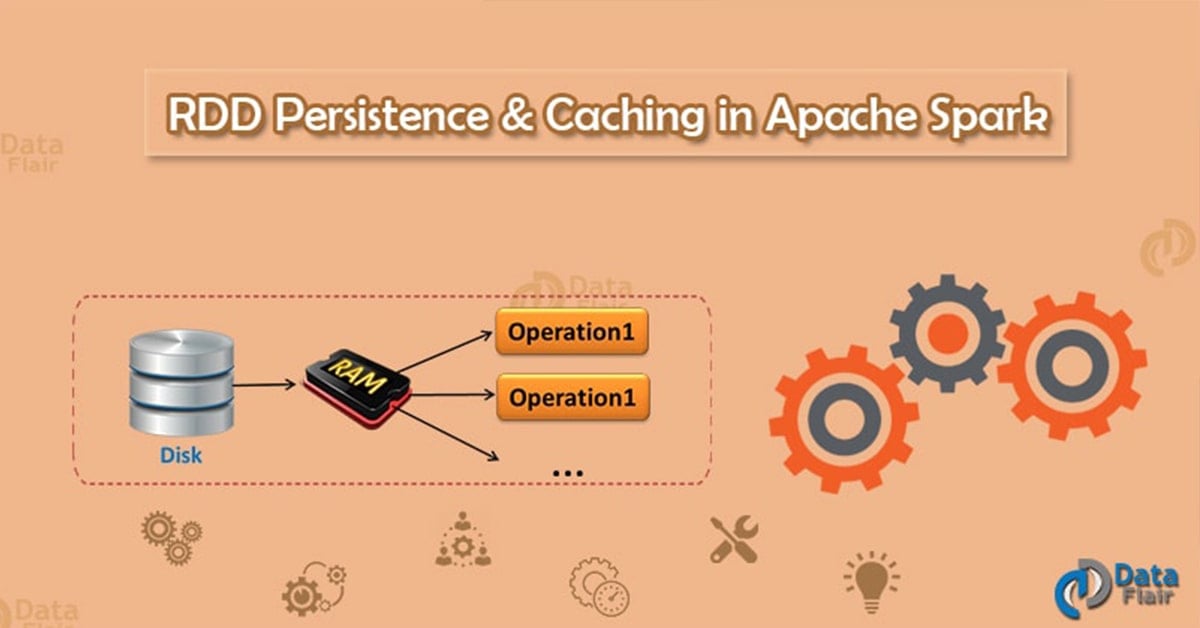RDD Persistence and Caching Mechanism in Apache Spark
1. Objective
This blog covers the detailed view of Apache Spark RDD Persistence and Caching. This tutorial gives the answers for – What is RDD persistence, Why do we need to call cache or persist on an RDD, What is the Difference between Cache() and Persist() method in Spark, What are the different storage levels in spark to store the persisted RDD, How to Unpersist RDD? The need of persisting RDD and various advantages of persistence are also discussed in this Spark tutorial.
2. What is RDD Persistence and Caching in Spark?
Spark RDD persistence is an optimization technique in which saves the result of RDD evaluation. Using this we save the intermediate result so that we can use it further if required. It reduces the computation overhead.
We can make persisted RDD through cache() and persist() methods. When we use the cache() method we can store all the RDD in-memory. We can persist the RDD in memory and use it efficiently across parallel operations.
The difference between cache() and persist() is that using cache() the default storage level is MEMORY_ONLY while using persist() we can use various storage levels (described below). It is a key tool for an interactive algorithm. Because, when we persist RDD each node stores any partition of it that it computes in memory and makes it reusable for future use. This process speeds up the further computation ten times.
When the RDD is computed for the first time, it is kept in memory on the node. The cache memory of the Spark is fault tolerant so whenever any partition of RDD is lost, it can be recovered by transformation Operation that originally created it.
3. Need of Persistence in Apache Spark
In Spark, we can use some RDD’s multiple times. If honestly, we repeat the same process of RDD evaluation each time it required or brought into action. This task can be time and memory consuming, especially for iterative algorithms that look at data multiple times. To solve the problem of repeated computation the technique of persistence came into the picture.
4. Benefits of RDD Persistence in Spark
There are some advantages of RDD caching and persistence mechanism in spark. It makes the whole system
- Time efficient
- Cost efficient
- Lessen the execution time.
5. Storage levels of Persisted RDDs
Using persist() we can use various storage levels to Store Persisted RDDs in Apache Spark. Let’s discuss each RDD storage level one by one-
a. MEMORY_ONLY
In this storage level, RDD is stored as deserialized Java object in the JVM. If the size of RDD is greater than memory, It will not cache some partition and recompute them next time whenever needed. In this level the space used for storage is very high, the CPU computation time is low, the data is stored in-memory. It does not make use of the disk.
b. MEMORY_AND_DISK
In this level, RDD is stored as deserialized Java object in the JVM. When the size of RDD is greater than the size of memory, it stores the excess partition on the disk, and retrieve from disk whenever required. In this level the space used for storage is high, the CPU computation time is medium, it makes use of both in-memory and on disk storage.
c. MEMORY_ONLY_SER
This level of Spark store the RDD as serialized Java object (one-byte array per partition). It is more space efficient as compared to deserialized objects, especially when it uses fast serializer. But it increases the overhead on CPU. In this level the storage space is low, the CPU computation time is high and the data is stored in-memory. It does not make use of the disk.
d. MEMORY_AND_DISK_SER
It is similar to MEMORY_ONLY_SER, but it drops the partition that does not fits into memory to disk, rather than recomputing each time it is needed. In this storage level, The space used for storage is low, the CPU computation time is high, it makes use of both in-memory and on disk storage.
e. DISK_ONLY
In this storage level, RDD is stored only on disk. The space used for storage is low, the CPU computation time is high and it makes use of on disk storage.
Refer this guide for the detailed description of Spark in-memory computation.
6. How to Unpersist RDD in Spark?
Spark monitor the cache of each node automatically and drop out the old data partition in the LRU (least recently used) fashion. LRU is an algorithm which ensures the least frequently used data. It spills out that data from the cache. We can also remove the cache manually using RDD.unpersist() method.
7. Conclusion
Hence, Caching or persistence are the optimization techniques for interactive and iterative Spark computations. It helps to save intermediate results so we can reuse them in subsequent stages. These intermediate results as RDDs are thus kept in memory (default) or more solid storages like disk and/or replicated.
What Next –
You give me 15 seconds I promise you best tutorials
Please share your happy experience on Google



nice expalinationa
if it is possible you have to give some example ………thanks for valuable info
Hi Ankur,
Thanks for the loyal feedback for Apache Spark RDD Persistence caching. Soon we will an example in this Spark Tutorial.
Keep Exploring and Keep Learning from DataFlair
can we specify disk storage location ?